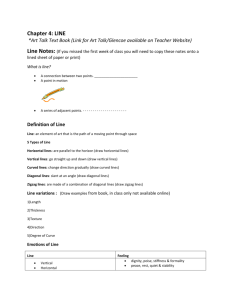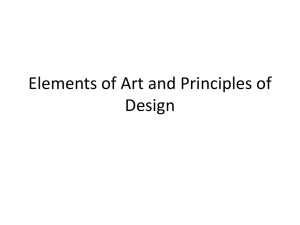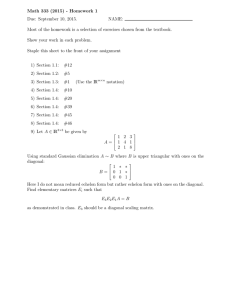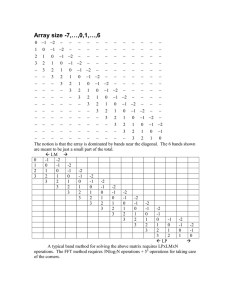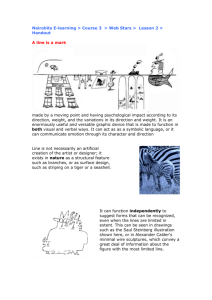Diagonal, Horizontal, Vertical Lesson Plan for Preschool
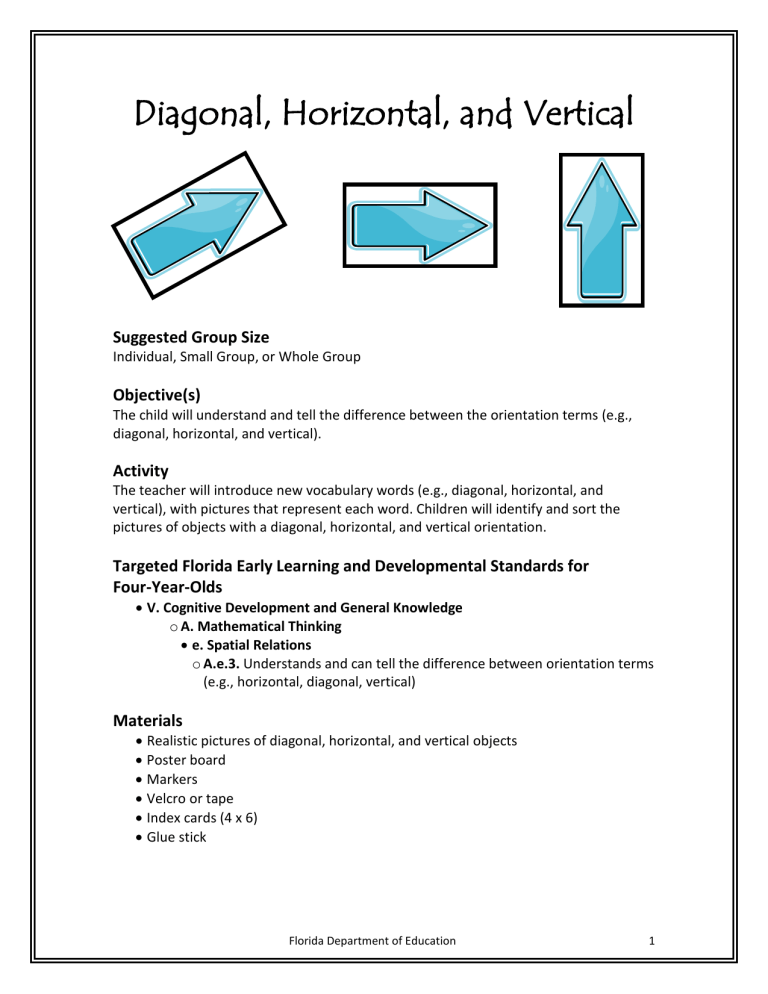
Diagonal, Horizontal, and Vertical
Suggested Group Size
Individual, Small Group, or Whole Group
Objective(s)
The child will understand and tell the difference between the orientation terms (e.g., diagonal, horizontal, and vertical).
Activity
The teacher will introduce new vocabulary words (e.g., diagonal, horizontal, and vertical), with pictures that represent each word. Children will identify and sort the pictures of objects with a diagonal, horizontal, and vertical orientation.
Targeted Florida Early Learning and Developmental Standards for
Four-Year-Olds
• V. Cognitive Development and General Knowledge o
A. Mathematical Thinking
• e. Spatial Relations o
A.e.3.
Understands and can tell the difference between orientation terms
(e.g., horizontal, diagonal, vertical)
Materials
• Realistic pictures of diagonal, horizontal, and vertical objects
• Poster board
• Markers
• Velcro or tape
• Index cards (4 x 6)
• Glue stick
Florida Department of Education 1
Procedures
1.
Before you begin the lesson, create the table below. Use the markers to draw the chart and write the orientation terms on the poster board. Cut out the pictures of the arrows (e.g., diagonal, horizontal, and vertical) and glue each one onto an index card. (You may choose to laminate the poster and arrow picture cards to make them more durable.) Place a piece of Velcro above each orientation term on the poster and on the back of each arrow picture card.
Attach five pieces of Velcro below each orientation term on the poster.
(Note: Velcro works best if the poster and picture cards are laminated.)
Diagonal Horizontal Vertical
2.
Cut out the remaining picture cards and glue them onto the index cards. (You may choose to laminate the picture cards to make them more durable.) Attach a piece of Velcro or tape to the back of each picture card. (Note: Velcro works best if the picture cards are laminated.)
3.
Explain to the children that they are going to learn three new words.
4.
Show the diagonal arrow and say, “Our first word is ‘ diagonal ’. Say, ‘diagonal’.
(Wait for the children to respond.) Yes, that’s right ‘ diagonal ’. (Place the diagonal arrow above the word ‘ diagonal ’ on the poster.) Now, I am going to show you some pictures of objects that are diagonal.” Show children the other picture card examples of diagonal.
5.
Show the horizontal arrow and say, “Our second word is ‘ horizontal ’. Say,
‘horizontal’. (Wait for the children to respond.) Yes, that’s right ‘ horizontal ’.
(Place the horizontal arrow above the word ‘ horizontal ’ on the poster.) Now, I am going to show you some pictures of objects that are horizontal.” Show children the other picture card examples of horizontal.
6.
Show the vertical arrow and say, “Our third word is ‘ vertical ’. Say, ‘vertical’.
(Wait for the children to respond.) Yes, that’s right ‘ vertical ’. (Place the vertical arrow above the word ‘ vertical ’ on the poster.) Now, I am going to show you some pictures of objects that are vertical.” Show children the other picture card examples of vertical.
Florida Department of Education 2
Procedures (continued)
7.
After the children have seen all of the picture cards, explain that now you will play a sorting game.
8.
Pass out a picture card to each child. Ask the children to look at their picture card and decide if it shows an object that is diagonal, horizontal, or vertical.
Have the children choose which arrow (e.g., diagonal, horizontal, or vertical) their picture card should go under on the poster. Allow each child to put his/her picture card on the poster.
9.
Repeat step eight until all of the picture cards have been sorted.
Adaptations
• Use real objects instead of picture cards to show the meaning of diagonal, horizontal, and vertical.
Extensions
• Allow children to use the poster and picture cards during center time.
• Use the new vocabulary during transitions: o
Lining up: You might say, “It’s time to line up to go outside. I need everyone to stand up straight and vertical and then line up at the back door.” o
Nap Time: You might say, “Alright, it’s time for everyone to lie down horizontally on their rest mats. I see _____ lying down horizontally on her rest mat.”
Checking for Understanding
Children will demonstrate their understanding of the lesson by:
• identifying and sorting pictures of objects with a diagonal, horizontal, and vertical orientation.
Related Standards for Four-Year-Olds
• I. Physical Development o
A. Health and Wellness
• A.2.
Shows visual abilities to facilitate learning and healthy growth and development
• IV. Language, Communication, and Emergent Literacy o
C. Vocabulary
• C.1.
Shows an understanding of words and their meanings
Florida Department of Education 3
Diagonal Picture Cards
Florida Department of Education 4
Diagonal Picture Cards (continued)
Florida Department of Education 5
Horizontal Picture Cards
Florida Department of Education 6
Horizontal Picture Cards (continued)
Florida Department of Education 7
Vertical Picture Cards
Florida Department of Education 8
Vertical Picture Cards (continued)
Florida Department of Education 9
Vertical Picture Cards (continued)
Florida Department of Education 10


